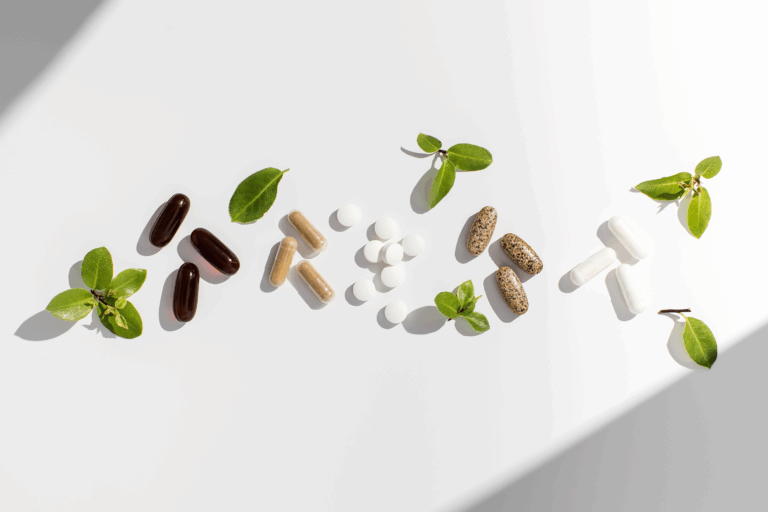Bitter Compounds in Digestive Health
Of the five basic tastes – sweet, sour, salty, bitter, and umami – bitter is probably the least appealing to most people.1 In fact, manufacturers have gone to great lengths to remove bitter compounds from foods to make them more palatable.2 But this has resulted in food items that are missing important compounds that can positively impact health, especially digestive health.
What Are Bitter Compounds?
Bitter chemical compounds are naturally found in some foods, especially plants, and elicit a bitter taste because they are intended to provide a defense against predators by making them unpalatable.2 These natural pesticides and compounds can be toxic to some animals, and the human senses perceive these compounds as bitter.2 This is likely a survival mechanism, enabling early humans to be sensitive to potentially poisonous plants.2 Some bitter chemical compounds may be harmful in high doses, but at the levels found in plants, they are typically beneficial for human health.2,3
Natural bitter compounds have been found to possess antioxidant and anti-cancer activities, improve elements of digestive health, decrease food intake, modulate glucose metabolism, and improve circulation.1-4 Other beneficial effects of bitters include antibiotic, antifungal, and sedative properties as well as the ability to help the cleanse the liver and reduce toxic accumulations.5
Humans vary in their sensitivity to bitter chemical compounds, typically falling into the categories of non-taster, supertaster, or medium taster.6 Sensitivity to bitter tastes may be important when considering overall diet composition, as it has been correlated with food preference and intake.7,8 You might see a patient who insists they are adverse to notoriously bitter foods, like cruciferous vegetables – and they are probably right. Bitter taste sensitivity is, in part, under genetic control and differences can be seen early in life, including among infants.9 While it may seem impossible for supertasters to tolerate any bitter compounds, some edible plants contain compounds that, when tasted together, synergistically inhibit bitter taste receptors so they are perceived as less bitter and more palatable.7
Bitter Foods and Drinks That Are Beneficial for Digestion
Many plants provide bitters that can support gut health:2,3
- Cruciferous vegetables, including broccoli, Brussels sprouts, and kale
- Tea
- Red wine
- Oats
- Citrus fruit such as lemons, grapefruit, oranges
These foods are rich in phytonutrients that are naturally bitter and modulate digestive processes including phenols, flavonoids, glucosinolates, isoflavones, terpenes, and other compounds.2,3
Estimates suggest that there are tens of thousands of bitter compounds, each with unique structures and diverse effects in the body.3 The phenolic quercetin is the most common bitter found in immature apples and other fruit and can positively impact digestive health through its antioxidant and anti-inflammatory properties, as well as through its ability to protect intestinal cell integrity and modulate the gut microbiome.2,10 Additionally, epicatechin gallate found in black and green teas can modulate gut hormone levels, which help regulate satiety and appetite, influencing energy and nutrient intake.3
Role of Bitter Compounds in Digestion
Bitter reflex
The beneficial effects of bitters in digestion are mediated primarily through bitter taste receptors.3 Upon activation of bitter receptors in the mouth, nerves on the tongue send signals via neurotransmitters to the vagus nerve which runs from the brain to enteroendocrine cells of the GI tract.4,5,7 The signals result in the priming of the digestive system, which includes:4,5,7
- Increasing saliva production in the mouth and hydrochloric acid production in the stomach
- Stimulating gastrin and pepsin secretions
- Initiating peristalsis
- Stimulating liver and gallbladder function including bile flow
- Enhancing enzyme production in the pancreas and small intestine
- Maintaining gut barrier integrity by supporting its repair
Bitter receptors in the gastrointestinal tract
Bitter taste receptors are also located in the gastrointestinal (GI) tract.3,4 Activation of taste receptors in the GI tract results in the release of gut hormones due to the co-localization of entero-endocrine cells with taste receptors within the GI tract.1 Some of the gut hormones that can be influenced by bitter taste reception activation include CCK (cholecystokinin), GLP-1 (glucagon-like peptide-1), PYY, and ghrelin.1,3 These hormones are able to influence eating behavior via modulating gastric motility, slowing gastric emptying, and reducing energy intake.1,3 Bitter taste receptors in the GI tract also likely interact with residents of the gut microbiome to influence digestive processes and overall health.8
Taste 2 receptors
Humans possess 25 subtypes of the bitter taste receptors named taste 2 receptors (TAS2Rs).3 This family of receptors exhibits complex physiology, with some bitter compounds activating a single TAS2R subtype while others activate multiple.3 For example, salicin from willow bark activates a single subtype while quinine from the bark of the cinchona tree activates nine subtypes.3 TAS2Rs are co-expressed randomly in cells, with a set of five to ten being expressed on any given cell out of the 25 possible subtypes.11 TAS2R subtypes also express unique single nucleotide polymorphisms, or genetic mutations, which may contribute to the natural differences people exhibit for bitter taste perception, food preferences, and food consumption.3
When consumption of bitter compounds is lacking, it may result in changes to digestion, metabolism, and overall energy intake. Bitter chemical compounds do not provide energy nor contribute directly to overall caloric intake, but they are important regulators of food intake.3 The ability of bitter compounds to regulate GI function, including appetite and digestive processes can influence food intake, energy intake, and metabolism.8 When food intake and consequently energy intake are elevated due to increased appetite, it can lead to weight gain. Conversely, when bitter compounds activate receptors that release gut hormones that curb appetite, it may help with weight control. Without proper activation of bitter taste receptors, food intake may become dysregulated, influencing the risk of metabolic diseases including obesity and diabetes.8,12
Bitter compounds in glucose metabolism
Some bitter compounds also play a role in glucose metabolism, including through influencing digestive processes. The ability of bitter compounds to affect gastric emptying and gut hormone release is relevant to the glycemic response after a meal. Slow gastric emptying can trigger further secretion of gut hormones as well as enhance the feeling of fullness, resulting in fewer calories being consumed.3 Bitter compounds are also able to regulate secretion of insulin, glucagon, and GLP-1, important hormones for blood glucose metabolism.3,5,14 Gymnema sylvestre (gymnema) and Momordica charantia (bitter melon) are bitter herbs that can improve digestion but also function as potent hypoglycemic agents, lowering blood glucose levels.7,13
TAS2Rs specifically play a role in glucose homeostasis and nutrient sensing, including modulating gut motility and secretion of appetite and satiety hormones.8 TAS2R in the GI tract are co-localized with glucose transporters, allowing bitter compounds to regulate the actions of glucose transporters. Additionally, genetic mutations in TAS2R subtypes can significantly impact glucose homeostasis, indicating a role for TAS2Rs in dysregulated glucose and insulin homeostasis.9
Bitter Herbs and Digestion
Bitter herbs have been utilized in many traditional healing systems for their ability to treat digestive disorders.4,15 Herbs containing bitters that support gut health and digestion include Taraxacum officinale (dandelion root), Citrus reticulata (orange peel), Gentiana lutea (gentian root), Cynara scolymus (artichoke leaf), and Humulus lupulus (bark of the cinchona tree), and Artemisia absinthium (wormwood).3,4,7,16 The herbs gentian and wormwood can increase secretion of gastric juice and bile via stimulating gustatory nerves in the mouth, which results in enhanced appetite and digestion.17 Both have been used to prevent and relieve dyspepsia.17 Ginger rhizome (Zingiber officinale) has also been used historically and in modern times for alleviating of variety GI complaints including dyspepsia, flatulence, vomiting, and diarrhea, as well as for appetite stimulation.18 Additionally, the natural bitter berberine in Coptis chinensis (Chinese goldthread) can modulate gut hormone levels, contributing to digestive health and appetite.3
Translating Pre-clinical Evidence to Humans
Results from clinical studies often differ, but overall, the research demonstrates that bitter compounds can modestly decrease energy intake, hunger, and food consumption while increasing satiety and fullness.1 Several human trials have found positive effects, including reduced caloric intake. The caloric reduction was modest, about 11 to 88 calories when given acutely or 340 calories when administered daily, but over time those effects can significantly impact overall caloric intake and metabolism, especially when combined with a healthy diet and regulate physical activity.1 Humans have complex physiological processes, especially digestion, making it difficult to tease apart specific effects and therapeutic potential of consuming bitter compounds for digestion. Additionally, there is not a single, generalized bitter effect, further complicating scientific efforts.4
- Klaassen, T., Keszthelyi, D., Troost, F.J., Bast, A., Masclee, A.A.M. (2021). Effects of gastrointestinal delivery of non-caloric tastants on energy intake: a systematic review and meta-analysis. Eur J Nutr, 60:2923.
- Drewnowski, A., Gomez-Carneros, C. (2000). Bitter taste, phytonutrients, and the consumer: a review. Am J Clin Nutr, 72:1424.
- Rezaie, P., Bitarafan, V., Horowitz, M., Feinle-Bisset, C. (2021). Effects of Bitter Substances on GI Function, Energy Intake and Glycaemia- Do Preclinical Findings Translate to Outcomes in Humans? Nutrients, 13:1317.
- McMullen, M. (2017). The Use of Bitter Herbs in Practice. Int J Complement Altern Med, 6(5):00198.
- Deshmukh, D., Baghel, V.S., Shastri, D., Nandini, D., Chauhan, N.S. (2010). Plant as bitter. Int J Adv Pharm Sci, 1:334.
- Loper, H.B., La Sala, M., Dotson, C., Steinle, N. (2015). Taste perception, associated hormonal modulation, and nutrient intake. Nutr Rev, 73(2):83.
- Byers, S. (2012). A New Taste for Bitters. Journal of the American Herbalists Guild, 10(2):24.
- Turner, A., Veysey, M., Keely, S., Scarlett, C., Lucock, M., Beckett, E.L. (2018). Interactions between Bitter Taste, Diet, and Dysbiosis: Consequences for Appetite and Obesity. Nutrients, 10:1336.
- Jeruzal-Świątecka, J., Fendler, W., Pietruszewska, W. (2020). Clinical Role of Extraoral Bitter Taste Receptors. Int J Mol Sci, 21:5156.
- Uyanga, V.A., Amevor, F.K., Liu, M., Cui, Z., Zhao, X., Lin, H. (2021). Potential Implications of Citrulline and Quercetin on Gut Functioning of Monogastric Animals and Humans: A Comprehensive Review. Nutrients, 13(11):3782.
- Wooding, S.P., Ramirez, V.A., Behrens, M. (2021). Bitter taste receptors: Genes, evolution and health. Evol Med Public Health, 9(1):431.
- Depoortere, I. (2014). Taste receptors of the gut: emerging roles in health and disease. Gut, 63(1):179.
- Basch, E., Gabardi, S., Ulbricht, C. (2003). Bitter melon (Momordica charantia): A review of efficacy and safety. Am J Health Syst Pharm, 60(4):356.
- Kim, B., Lee, H.S., Kim, H.-J., Lee, H., Lee, I.-Y., Ock, S., Kwon, S., Kang, S.-S., Choi, Y. (2022). Momordica charantia (bitter melon) efficacy and safety on glucose metabolism in Korean prediabetes participants: a 12-week, randomized clinical study. Food Sci Biotechnol, 32(5):697.
- Behrens, M., Gu, M., Fan, S., Huang, C., Meyerhof, W. (2018). Bitter substances from plants used in traditional Chinese medicine exert biased activation of human bitter taste receptors. Chem Biol Drug Des, 91(2):422.
- Valussi, M. (2012). Functional foods with digestion-enhancing properties. Int J Food Sci Nutr, 63 Suppl1:82.
- McMullen, M.K., Whitehouse, J.M., Towell, A. (2015). Bitters: Time for a New Paradigm. Evid Based Complementary Altern Med, 2015:670504.
- Valussi, M. (2012). Functional foods with digestion-enhancing properties. Int J Food Sci Nutr, 63 Suppl 1:82.






